HR Report: ASDA's Approach to Individual, Team, and Org Development
VerifiedAdded on 2023/01/04
|21
|6965
|30
Report
AI Summary
This report, written from the perspective of ASDA, a retail business, examines key aspects of human resource management and organizational development. It begins by outlining the essential professional knowledge, behaviors, and skills required of HR professionals, emphasizing the importance of education, experience, and specific competencies like communication and problem-solving. The report then analyzes a personal skills audit, identifying strengths and weaknesses and formulating a professional development plan focused on improving communication and leadership skills. Furthermore, it explores the differences between individual and organizational learning, training, and development, and highlights the significance of continuous learning and professional development for driving sustainable business performance. Finally, the report demonstrates how high-performance work systems (HPWS) contribute to employee engagement and competitive advantage within an organizational context and evaluates various approaches to performance management, such as collaborative working, to support a high-performance culture.
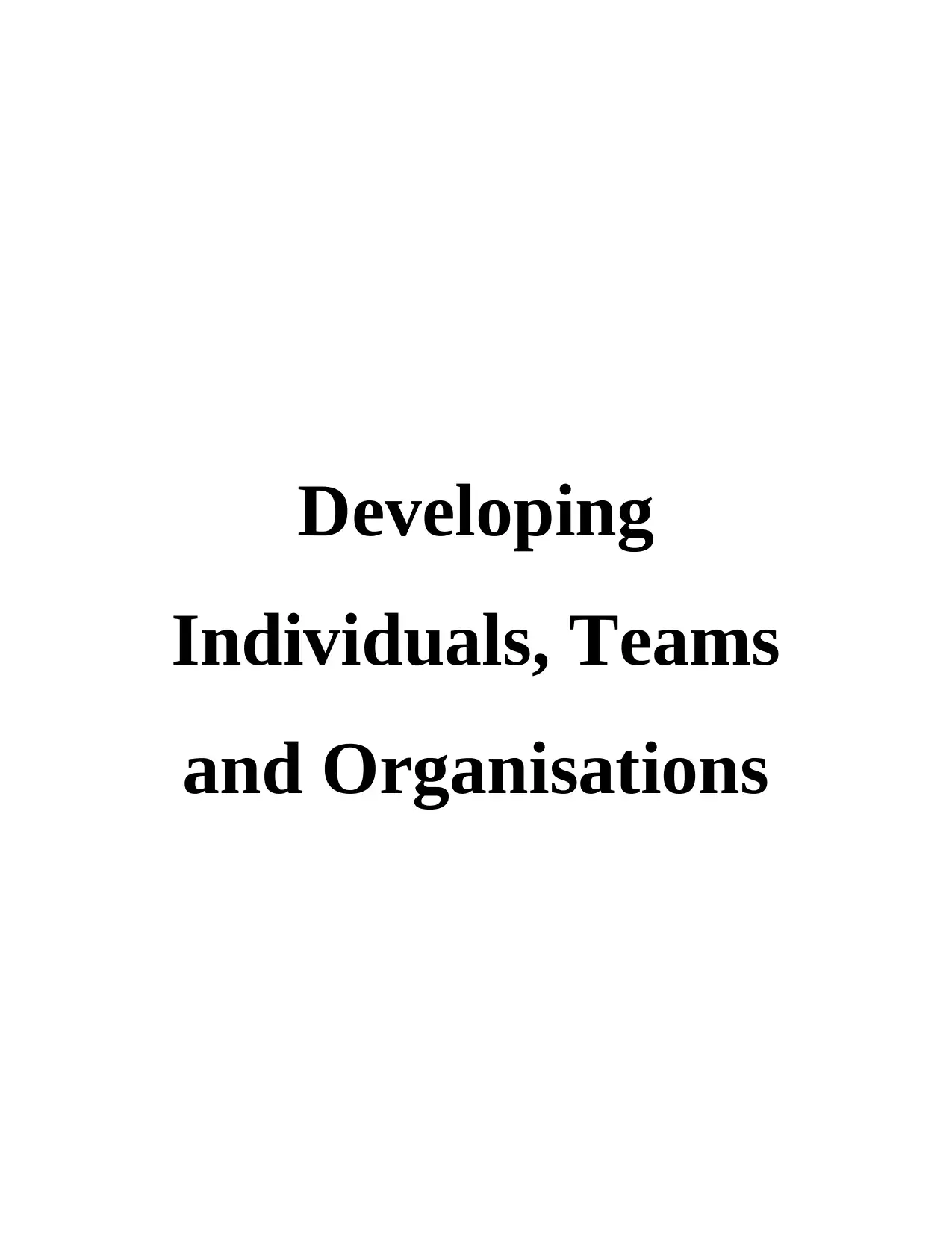
Developing
Individuals, Teams
and Organisations
Individuals, Teams
and Organisations
Paraphrase This Document
Need a fresh take? Get an instant paraphrase of this document with our AI Paraphraser
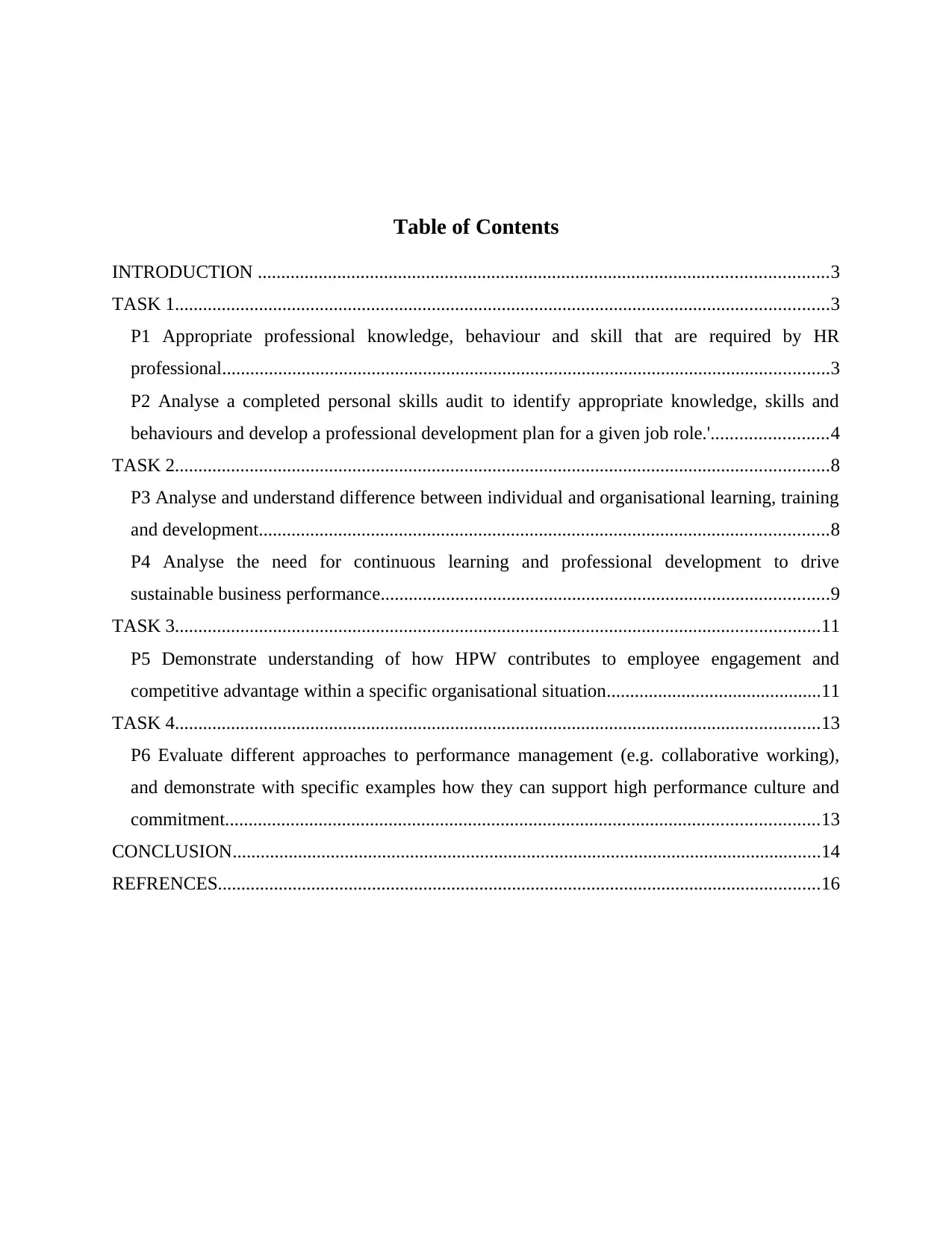
Table of Contents
INTRODUCTION ..........................................................................................................................3
TASK 1............................................................................................................................................3
P1 Appropriate professional knowledge, behaviour and skill that are required by HR
professional..................................................................................................................................3
P2 Analyse a completed personal skills audit to identify appropriate knowledge, skills and
behaviours and develop a professional development plan for a given job role.'.........................4
TASK 2............................................................................................................................................8
P3 Analyse and understand difference between individual and organisational learning, training
and development..........................................................................................................................8
P4 Analyse the need for continuous learning and professional development to drive
sustainable business performance................................................................................................9
TASK 3..........................................................................................................................................11
P5 Demonstrate understanding of how HPW contributes to employee engagement and
competitive advantage within a specific organisational situation..............................................11
TASK 4..........................................................................................................................................13
P6 Evaluate different approaches to performance management (e.g. collaborative working),
and demonstrate with specific examples how they can support high performance culture and
commitment...............................................................................................................................13
CONCLUSION..............................................................................................................................14
REFRENCES.................................................................................................................................16
INTRODUCTION ..........................................................................................................................3
TASK 1............................................................................................................................................3
P1 Appropriate professional knowledge, behaviour and skill that are required by HR
professional..................................................................................................................................3
P2 Analyse a completed personal skills audit to identify appropriate knowledge, skills and
behaviours and develop a professional development plan for a given job role.'.........................4
TASK 2............................................................................................................................................8
P3 Analyse and understand difference between individual and organisational learning, training
and development..........................................................................................................................8
P4 Analyse the need for continuous learning and professional development to drive
sustainable business performance................................................................................................9
TASK 3..........................................................................................................................................11
P5 Demonstrate understanding of how HPW contributes to employee engagement and
competitive advantage within a specific organisational situation..............................................11
TASK 4..........................................................................................................................................13
P6 Evaluate different approaches to performance management (e.g. collaborative working),
and demonstrate with specific examples how they can support high performance culture and
commitment...............................................................................................................................13
CONCLUSION..............................................................................................................................14
REFRENCES.................................................................................................................................16
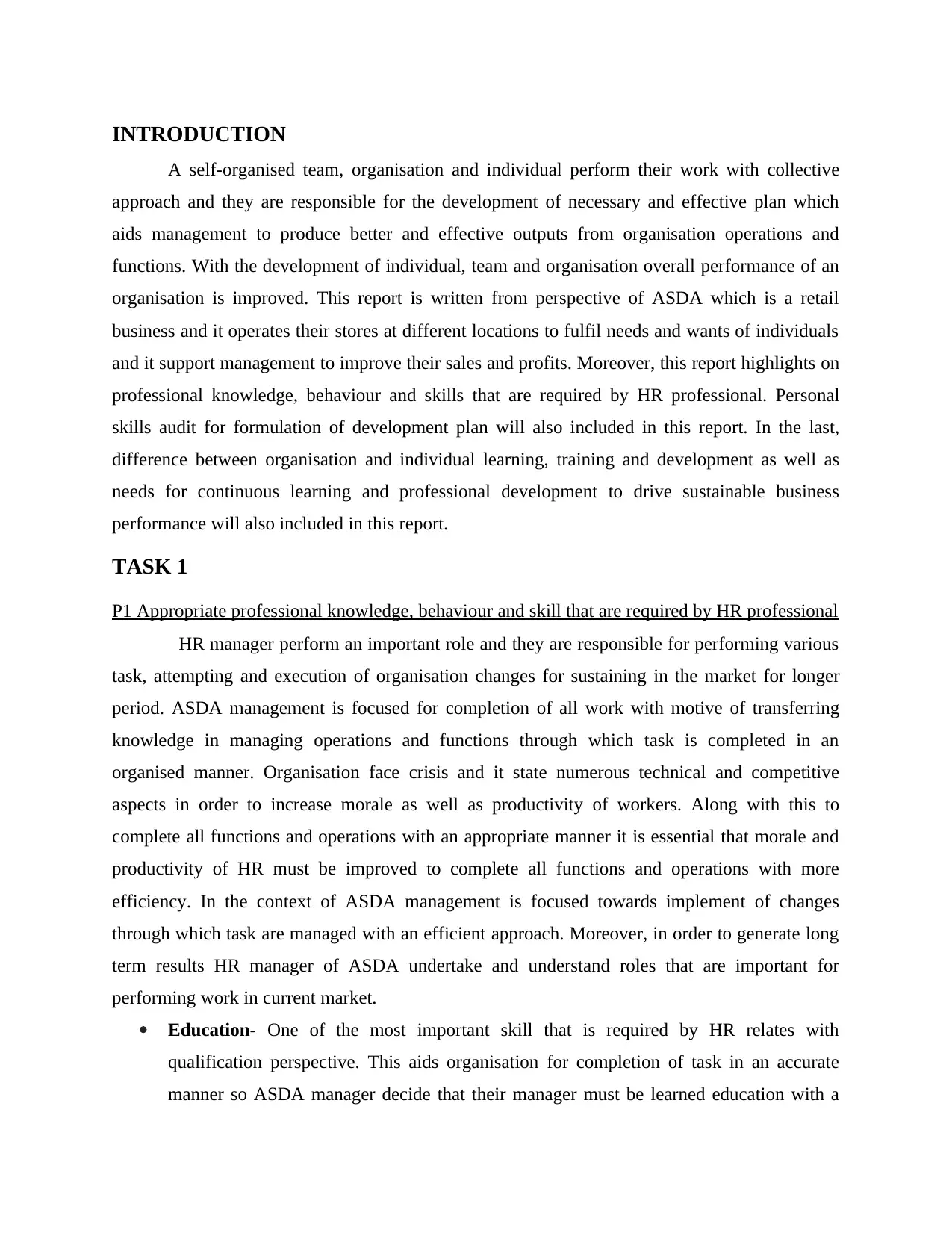
INTRODUCTION
A self-organised team, organisation and individual perform their work with collective
approach and they are responsible for the development of necessary and effective plan which
aids management to produce better and effective outputs from organisation operations and
functions. With the development of individual, team and organisation overall performance of an
organisation is improved. This report is written from perspective of ASDA which is a retail
business and it operates their stores at different locations to fulfil needs and wants of individuals
and it support management to improve their sales and profits. Moreover, this report highlights on
professional knowledge, behaviour and skills that are required by HR professional. Personal
skills audit for formulation of development plan will also included in this report. In the last,
difference between organisation and individual learning, training and development as well as
needs for continuous learning and professional development to drive sustainable business
performance will also included in this report.
TASK 1
P1 Appropriate professional knowledge, behaviour and skill that are required by HR professional
HR manager perform an important role and they are responsible for performing various
task, attempting and execution of organisation changes for sustaining in the market for longer
period. ASDA management is focused for completion of all work with motive of transferring
knowledge in managing operations and functions through which task is completed in an
organised manner. Organisation face crisis and it state numerous technical and competitive
aspects in order to increase morale as well as productivity of workers. Along with this to
complete all functions and operations with an appropriate manner it is essential that morale and
productivity of HR must be improved to complete all functions and operations with more
efficiency. In the context of ASDA management is focused towards implement of changes
through which task are managed with an efficient approach. Moreover, in order to generate long
term results HR manager of ASDA undertake and understand roles that are important for
performing work in current market.
Education- One of the most important skill that is required by HR relates with
qualification perspective. This aids organisation for completion of task in an accurate
manner so ASDA manager decide that their manager must be learned education with a
A self-organised team, organisation and individual perform their work with collective
approach and they are responsible for the development of necessary and effective plan which
aids management to produce better and effective outputs from organisation operations and
functions. With the development of individual, team and organisation overall performance of an
organisation is improved. This report is written from perspective of ASDA which is a retail
business and it operates their stores at different locations to fulfil needs and wants of individuals
and it support management to improve their sales and profits. Moreover, this report highlights on
professional knowledge, behaviour and skills that are required by HR professional. Personal
skills audit for formulation of development plan will also included in this report. In the last,
difference between organisation and individual learning, training and development as well as
needs for continuous learning and professional development to drive sustainable business
performance will also included in this report.
TASK 1
P1 Appropriate professional knowledge, behaviour and skill that are required by HR professional
HR manager perform an important role and they are responsible for performing various
task, attempting and execution of organisation changes for sustaining in the market for longer
period. ASDA management is focused for completion of all work with motive of transferring
knowledge in managing operations and functions through which task is completed in an
organised manner. Organisation face crisis and it state numerous technical and competitive
aspects in order to increase morale as well as productivity of workers. Along with this to
complete all functions and operations with an appropriate manner it is essential that morale and
productivity of HR must be improved to complete all functions and operations with more
efficiency. In the context of ASDA management is focused towards implement of changes
through which task are managed with an efficient approach. Moreover, in order to generate long
term results HR manager of ASDA undertake and understand roles that are important for
performing work in current market.
Education- One of the most important skill that is required by HR relates with
qualification perspective. This aids organisation for completion of task in an accurate
manner so ASDA manager decide that their manager must be learned education with a
⊘ This is a preview!⊘
Do you want full access?
Subscribe today to unlock all pages.

Trusted by 1+ million students worldwide
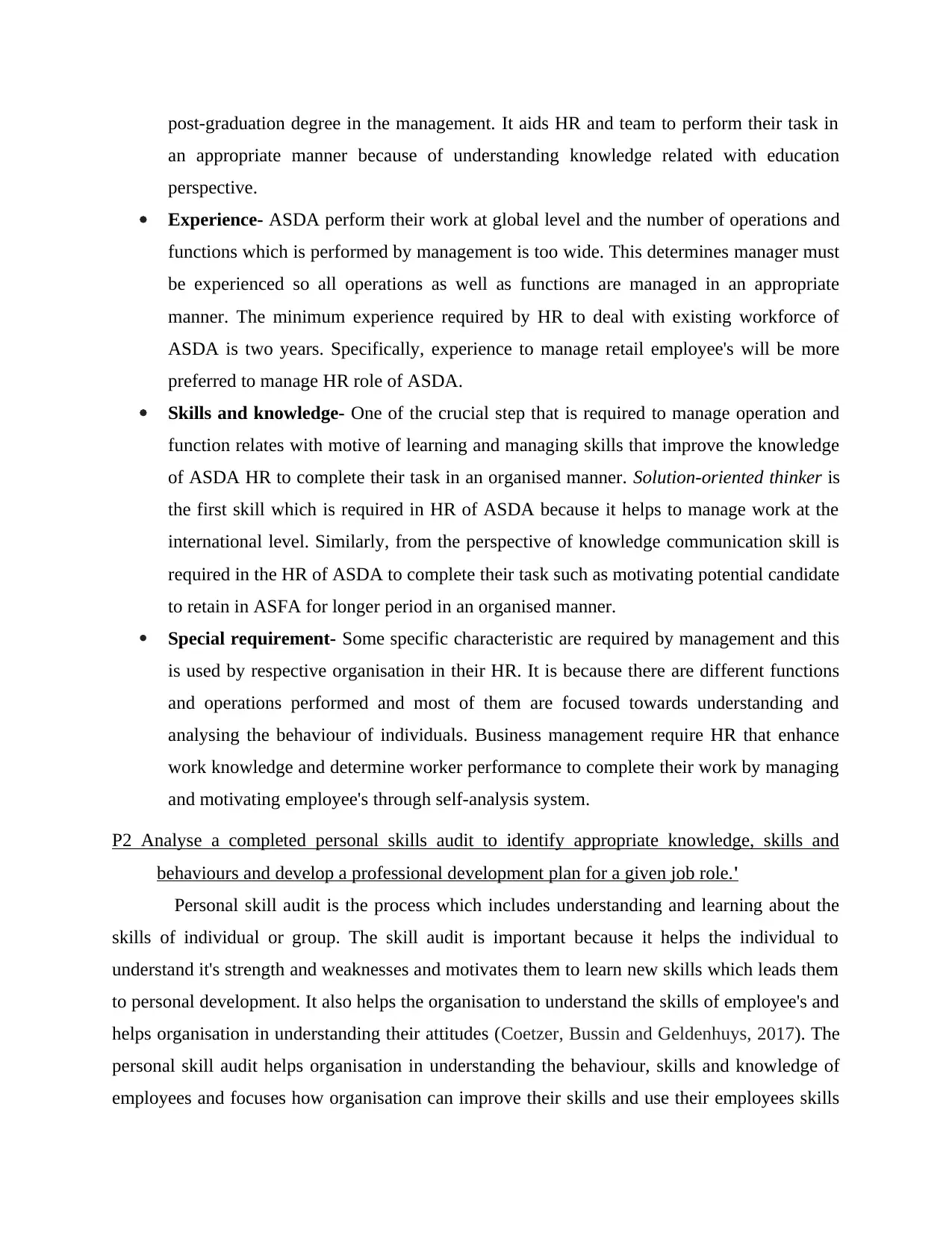
post-graduation degree in the management. It aids HR and team to perform their task in
an appropriate manner because of understanding knowledge related with education
perspective.
Experience- ASDA perform their work at global level and the number of operations and
functions which is performed by management is too wide. This determines manager must
be experienced so all operations as well as functions are managed in an appropriate
manner. The minimum experience required by HR to deal with existing workforce of
ASDA is two years. Specifically, experience to manage retail employee's will be more
preferred to manage HR role of ASDA.
Skills and knowledge- One of the crucial step that is required to manage operation and
function relates with motive of learning and managing skills that improve the knowledge
of ASDA HR to complete their task in an organised manner. Solution-oriented thinker is
the first skill which is required in HR of ASDA because it helps to manage work at the
international level. Similarly, from the perspective of knowledge communication skill is
required in the HR of ASDA to complete their task such as motivating potential candidate
to retain in ASFA for longer period in an organised manner.
Special requirement- Some specific characteristic are required by management and this
is used by respective organisation in their HR. It is because there are different functions
and operations performed and most of them are focused towards understanding and
analysing the behaviour of individuals. Business management require HR that enhance
work knowledge and determine worker performance to complete their work by managing
and motivating employee's through self-analysis system.
P2 Analyse a completed personal skills audit to identify appropriate knowledge, skills and
behaviours and develop a professional development plan for a given job role.'
Personal skill audit is the process which includes understanding and learning about the
skills of individual or group. The skill audit is important because it helps the individual to
understand it's strength and weaknesses and motivates them to learn new skills which leads them
to personal development. It also helps the organisation to understand the skills of employee's and
helps organisation in understanding their attitudes (Coetzer, Bussin and Geldenhuys, 2017). The
personal skill audit helps organisation in understanding the behaviour, skills and knowledge of
employees and focuses how organisation can improve their skills and use their employees skills
an appropriate manner because of understanding knowledge related with education
perspective.
Experience- ASDA perform their work at global level and the number of operations and
functions which is performed by management is too wide. This determines manager must
be experienced so all operations as well as functions are managed in an appropriate
manner. The minimum experience required by HR to deal with existing workforce of
ASDA is two years. Specifically, experience to manage retail employee's will be more
preferred to manage HR role of ASDA.
Skills and knowledge- One of the crucial step that is required to manage operation and
function relates with motive of learning and managing skills that improve the knowledge
of ASDA HR to complete their task in an organised manner. Solution-oriented thinker is
the first skill which is required in HR of ASDA because it helps to manage work at the
international level. Similarly, from the perspective of knowledge communication skill is
required in the HR of ASDA to complete their task such as motivating potential candidate
to retain in ASFA for longer period in an organised manner.
Special requirement- Some specific characteristic are required by management and this
is used by respective organisation in their HR. It is because there are different functions
and operations performed and most of them are focused towards understanding and
analysing the behaviour of individuals. Business management require HR that enhance
work knowledge and determine worker performance to complete their work by managing
and motivating employee's through self-analysis system.
P2 Analyse a completed personal skills audit to identify appropriate knowledge, skills and
behaviours and develop a professional development plan for a given job role.'
Personal skill audit is the process which includes understanding and learning about the
skills of individual or group. The skill audit is important because it helps the individual to
understand it's strength and weaknesses and motivates them to learn new skills which leads them
to personal development. It also helps the organisation to understand the skills of employee's and
helps organisation in understanding their attitudes (Coetzer, Bussin and Geldenhuys, 2017). The
personal skill audit helps organisation in understanding the behaviour, skills and knowledge of
employees and focuses how organisation can improve their skills and use their employees skills
Paraphrase This Document
Need a fresh take? Get an instant paraphrase of this document with our AI Paraphraser
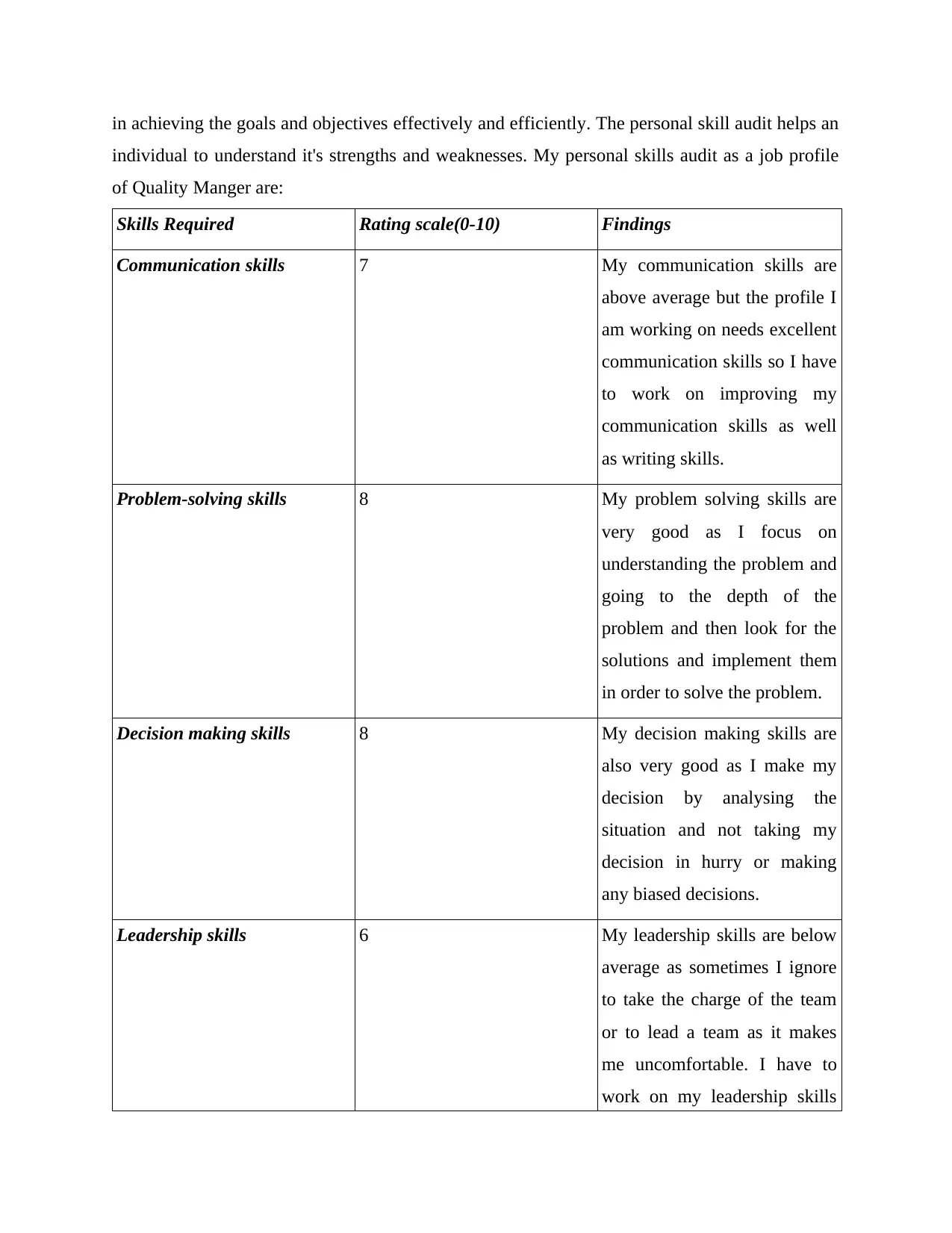
in achieving the goals and objectives effectively and efficiently. The personal skill audit helps an
individual to understand it's strengths and weaknesses. My personal skills audit as a job profile
of Quality Manger are:
Skills Required Rating scale(0-10) Findings
Communication skills 7 My communication skills are
above average but the profile I
am working on needs excellent
communication skills so I have
to work on improving my
communication skills as well
as writing skills.
Problem-solving skills 8 My problem solving skills are
very good as I focus on
understanding the problem and
going to the depth of the
problem and then look for the
solutions and implement them
in order to solve the problem.
Decision making skills 8 My decision making skills are
also very good as I make my
decision by analysing the
situation and not taking my
decision in hurry or making
any biased decisions.
Leadership skills 6 My leadership skills are below
average as sometimes I ignore
to take the charge of the team
or to lead a team as it makes
me uncomfortable. I have to
work on my leadership skills
individual to understand it's strengths and weaknesses. My personal skills audit as a job profile
of Quality Manger are:
Skills Required Rating scale(0-10) Findings
Communication skills 7 My communication skills are
above average but the profile I
am working on needs excellent
communication skills so I have
to work on improving my
communication skills as well
as writing skills.
Problem-solving skills 8 My problem solving skills are
very good as I focus on
understanding the problem and
going to the depth of the
problem and then look for the
solutions and implement them
in order to solve the problem.
Decision making skills 8 My decision making skills are
also very good as I make my
decision by analysing the
situation and not taking my
decision in hurry or making
any biased decisions.
Leadership skills 6 My leadership skills are below
average as sometimes I ignore
to take the charge of the team
or to lead a team as it makes
me uncomfortable. I have to
work on my leadership skills
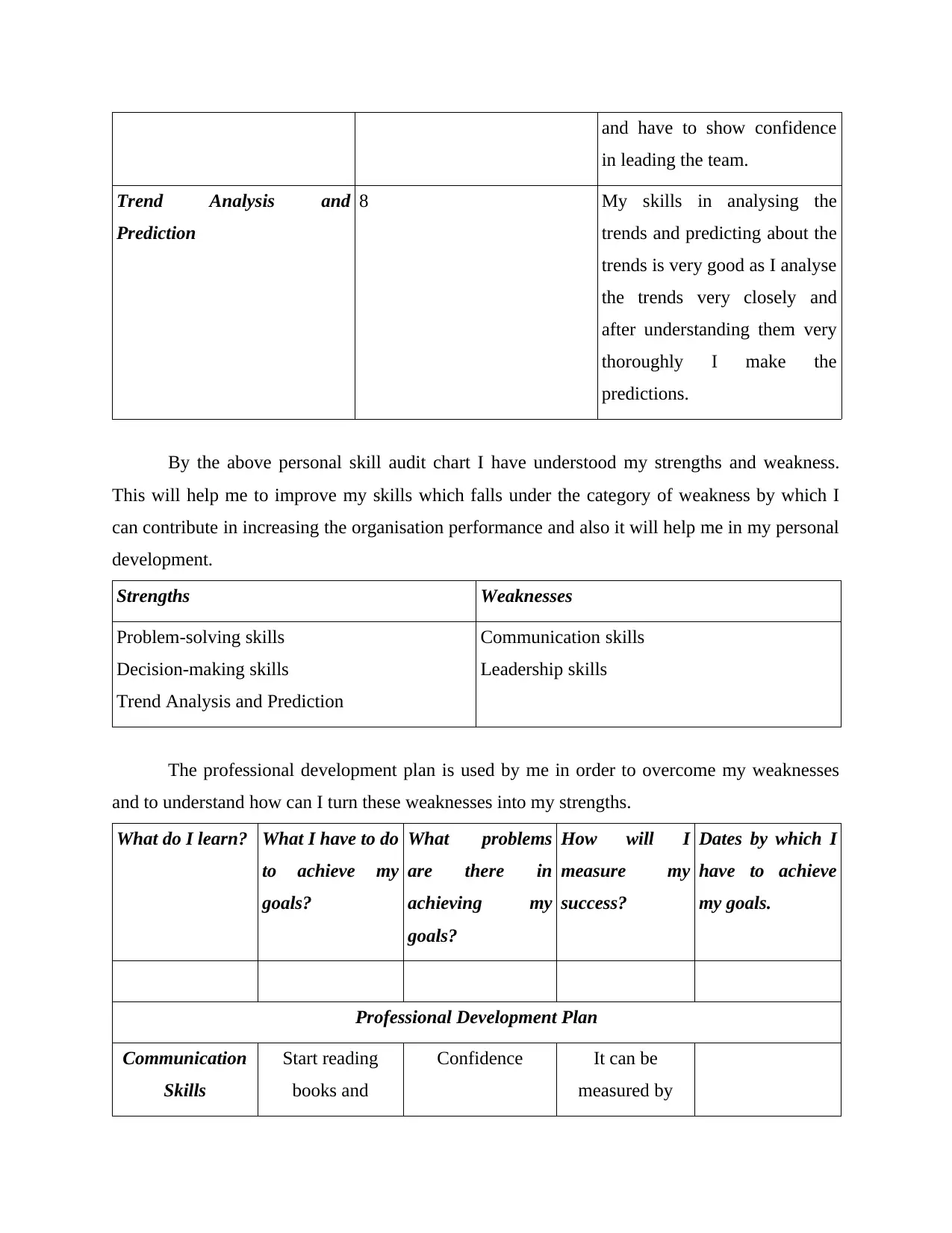
and have to show confidence
in leading the team.
Trend Analysis and
Prediction
8 My skills in analysing the
trends and predicting about the
trends is very good as I analyse
the trends very closely and
after understanding them very
thoroughly I make the
predictions.
By the above personal skill audit chart I have understood my strengths and weakness.
This will help me to improve my skills which falls under the category of weakness by which I
can contribute in increasing the organisation performance and also it will help me in my personal
development.
Strengths Weaknesses
Problem-solving skills
Decision-making skills
Trend Analysis and Prediction
Communication skills
Leadership skills
The professional development plan is used by me in order to overcome my weaknesses
and to understand how can I turn these weaknesses into my strengths.
What do I learn? What I have to do
to achieve my
goals?
What problems
are there in
achieving my
goals?
How will I
measure my
success?
Dates by which I
have to achieve
my goals.
Professional Development Plan
Communication
Skills
Start reading
books and
Confidence It can be
measured by
in leading the team.
Trend Analysis and
Prediction
8 My skills in analysing the
trends and predicting about the
trends is very good as I analyse
the trends very closely and
after understanding them very
thoroughly I make the
predictions.
By the above personal skill audit chart I have understood my strengths and weakness.
This will help me to improve my skills which falls under the category of weakness by which I
can contribute in increasing the organisation performance and also it will help me in my personal
development.
Strengths Weaknesses
Problem-solving skills
Decision-making skills
Trend Analysis and Prediction
Communication skills
Leadership skills
The professional development plan is used by me in order to overcome my weaknesses
and to understand how can I turn these weaknesses into my strengths.
What do I learn? What I have to do
to achieve my
goals?
What problems
are there in
achieving my
goals?
How will I
measure my
success?
Dates by which I
have to achieve
my goals.
Professional Development Plan
Communication
Skills
Start reading
books and
Confidence It can be
measured by
⊘ This is a preview!⊘
Do you want full access?
Subscribe today to unlock all pages.

Trusted by 1+ million students worldwide
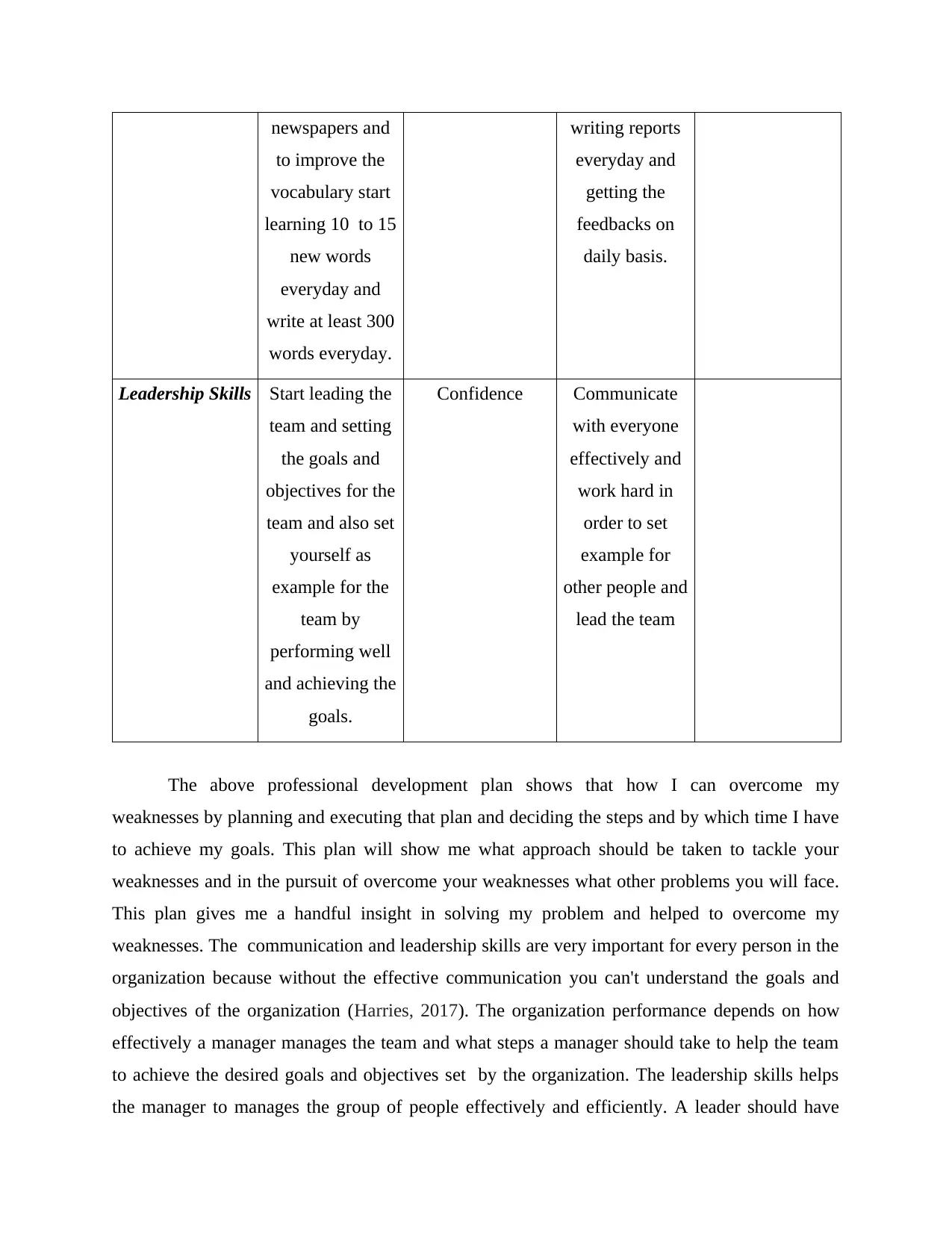
newspapers and
to improve the
vocabulary start
learning 10 to 15
new words
everyday and
write at least 300
words everyday.
writing reports
everyday and
getting the
feedbacks on
daily basis.
Leadership Skills Start leading the
team and setting
the goals and
objectives for the
team and also set
yourself as
example for the
team by
performing well
and achieving the
goals.
Confidence Communicate
with everyone
effectively and
work hard in
order to set
example for
other people and
lead the team
The above professional development plan shows that how I can overcome my
weaknesses by planning and executing that plan and deciding the steps and by which time I have
to achieve my goals. This plan will show me what approach should be taken to tackle your
weaknesses and in the pursuit of overcome your weaknesses what other problems you will face.
This plan gives me a handful insight in solving my problem and helped to overcome my
weaknesses. The communication and leadership skills are very important for every person in the
organization because without the effective communication you can't understand the goals and
objectives of the organization (Harries, 2017). The organization performance depends on how
effectively a manager manages the team and what steps a manager should take to help the team
to achieve the desired goals and objectives set by the organization. The leadership skills helps
the manager to manages the group of people effectively and efficiently. A leader should have
to improve the
vocabulary start
learning 10 to 15
new words
everyday and
write at least 300
words everyday.
writing reports
everyday and
getting the
feedbacks on
daily basis.
Leadership Skills Start leading the
team and setting
the goals and
objectives for the
team and also set
yourself as
example for the
team by
performing well
and achieving the
goals.
Confidence Communicate
with everyone
effectively and
work hard in
order to set
example for
other people and
lead the team
The above professional development plan shows that how I can overcome my
weaknesses by planning and executing that plan and deciding the steps and by which time I have
to achieve my goals. This plan will show me what approach should be taken to tackle your
weaknesses and in the pursuit of overcome your weaknesses what other problems you will face.
This plan gives me a handful insight in solving my problem and helped to overcome my
weaknesses. The communication and leadership skills are very important for every person in the
organization because without the effective communication you can't understand the goals and
objectives of the organization (Harries, 2017). The organization performance depends on how
effectively a manager manages the team and what steps a manager should take to help the team
to achieve the desired goals and objectives set by the organization. The leadership skills helps
the manager to manages the group of people effectively and efficiently. A leader should have
Paraphrase This Document
Need a fresh take? Get an instant paraphrase of this document with our AI Paraphraser
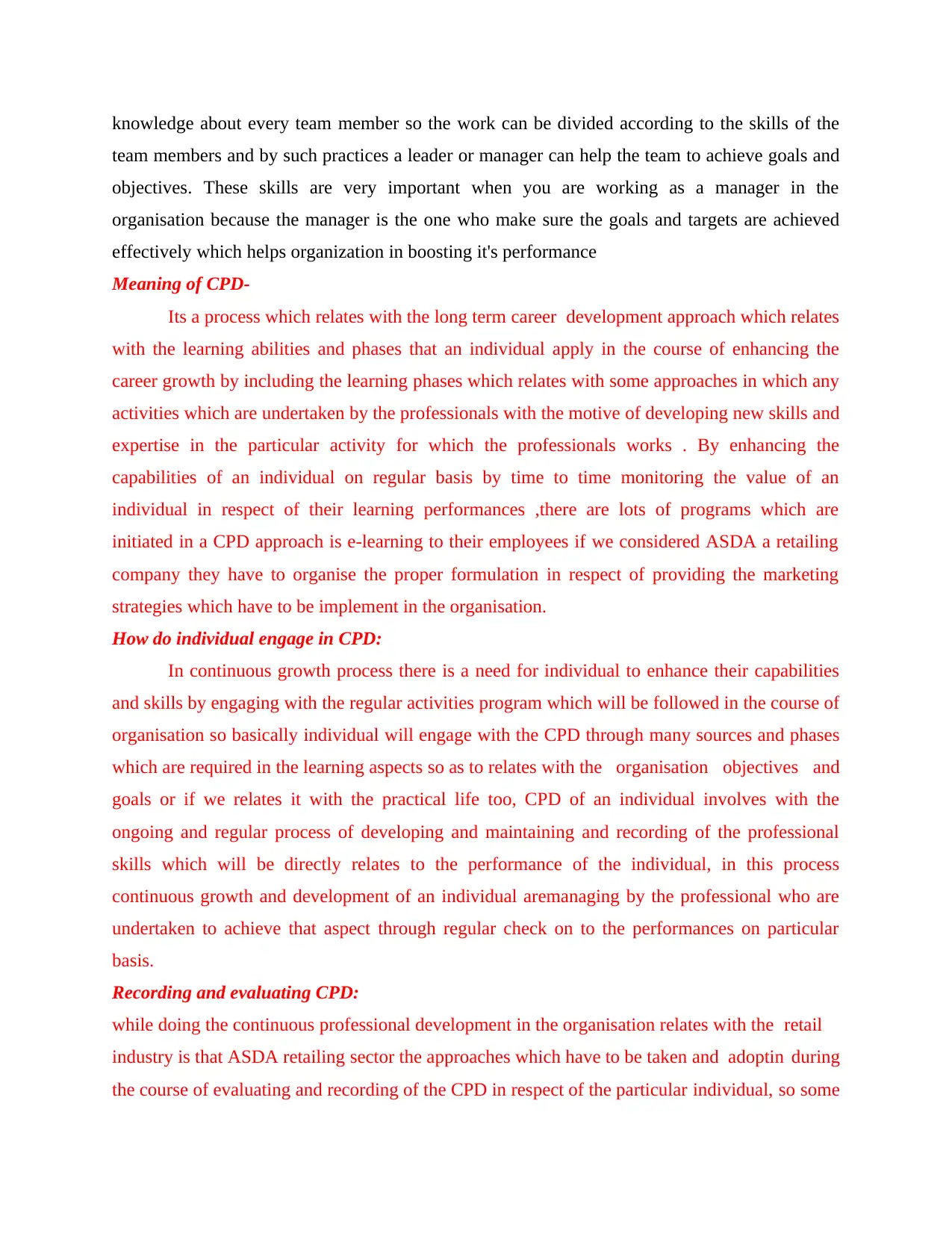
knowledge about every team member so the work can be divided according to the skills of the
team members and by such practices a leader or manager can help the team to achieve goals and
objectives. These skills are very important when you are working as a manager in the
organisation because the manager is the one who make sure the goals and targets are achieved
effectively which helps organization in boosting it's performance
Meaning of CPD-
Its a process which relates with the long term career development approach which relates
with the learning abilities and phases that an individual apply in the course of enhancing the
career growth by including the learning phases which relates with some approaches in which any
activities which are undertaken by the professionals with the motive of developing new skills and
expertise in the particular activity for which the professionals works . By enhancing the
capabilities of an individual on regular basis by time to time monitoring the value of an
individual in respect of their learning performances ,there are lots of programs which are
initiated in a CPD approach is e-learning to their employees if we considered ASDA a retailing
company they have to organise the proper formulation in respect of providing the marketing
strategies which have to be implement in the organisation.
How do individual engage in CPD:
In continuous growth process there is a need for individual to enhance their capabilities
and skills by engaging with the regular activities program which will be followed in the course of
organisation so basically individual will engage with the CPD through many sources and phases
which are required in the learning aspects so as to relates with the organisation objectives and
goals or if we relates it with the practical life too, CPD of an individual involves with the
ongoing and regular process of developing and maintaining and recording of the professional
skills which will be directly relates to the performance of the individual, in this process
continuous growth and development of an individual aremanaging by the professional who are
undertaken to achieve that aspect through regular check on to the performances on particular
basis.
Recording and evaluating CPD:
while doing the continuous professional development in the organisation relates with the retail
industry is that ASDA retailing sector the approaches which have to be taken and adoptin during
the course of evaluating and recording of the CPD in respect of the particular individual, so some
team members and by such practices a leader or manager can help the team to achieve goals and
objectives. These skills are very important when you are working as a manager in the
organisation because the manager is the one who make sure the goals and targets are achieved
effectively which helps organization in boosting it's performance
Meaning of CPD-
Its a process which relates with the long term career development approach which relates
with the learning abilities and phases that an individual apply in the course of enhancing the
career growth by including the learning phases which relates with some approaches in which any
activities which are undertaken by the professionals with the motive of developing new skills and
expertise in the particular activity for which the professionals works . By enhancing the
capabilities of an individual on regular basis by time to time monitoring the value of an
individual in respect of their learning performances ,there are lots of programs which are
initiated in a CPD approach is e-learning to their employees if we considered ASDA a retailing
company they have to organise the proper formulation in respect of providing the marketing
strategies which have to be implement in the organisation.
How do individual engage in CPD:
In continuous growth process there is a need for individual to enhance their capabilities
and skills by engaging with the regular activities program which will be followed in the course of
organisation so basically individual will engage with the CPD through many sources and phases
which are required in the learning aspects so as to relates with the organisation objectives and
goals or if we relates it with the practical life too, CPD of an individual involves with the
ongoing and regular process of developing and maintaining and recording of the professional
skills which will be directly relates to the performance of the individual, in this process
continuous growth and development of an individual aremanaging by the professional who are
undertaken to achieve that aspect through regular check on to the performances on particular
basis.
Recording and evaluating CPD:
while doing the continuous professional development in the organisation relates with the retail
industry is that ASDA retailing sector the approaches which have to be taken and adoptin during
the course of evaluating and recording of the CPD in respect of the particular individual, so some
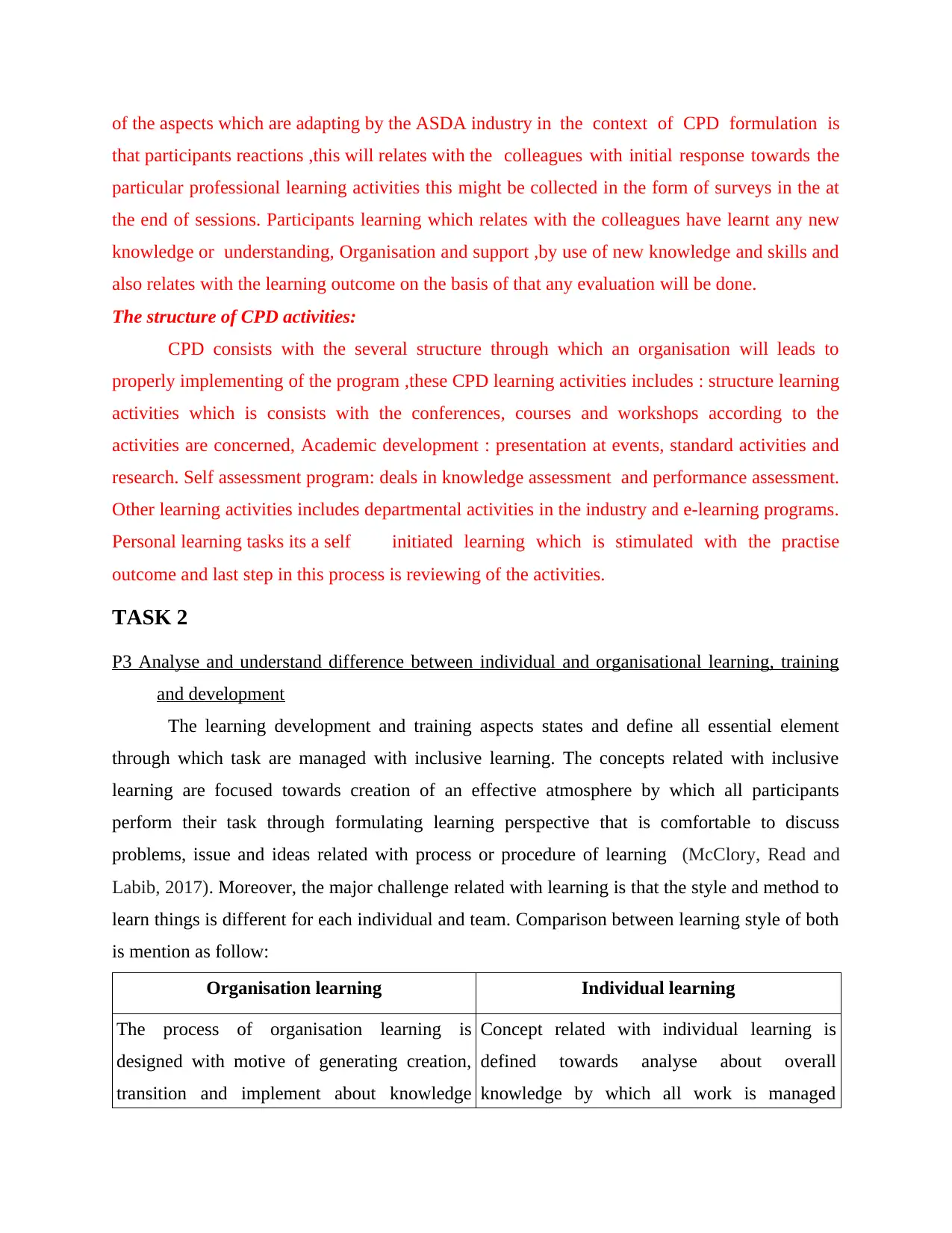
of the aspects which are adapting by the ASDA industry in the context of CPD formulation is
that participants reactions ,this will relates with the colleagues with initial response towards the
particular professional learning activities this might be collected in the form of surveys in the at
the end of sessions. Participants learning which relates with the colleagues have learnt any new
knowledge or understanding, Organisation and support ,by use of new knowledge and skills and
also relates with the learning outcome on the basis of that any evaluation will be done.
The structure of CPD activities:
CPD consists with the several structure through which an organisation will leads to
properly implementing of the program ,these CPD learning activities includes : structure learning
activities which is consists with the conferences, courses and workshops according to the
activities are concerned, Academic development : presentation at events, standard activities and
research. Self assessment program: deals in knowledge assessment and performance assessment.
Other learning activities includes departmental activities in the industry and e-learning programs.
Personal learning tasks its a self initiated learning which is stimulated with the practise
outcome and last step in this process is reviewing of the activities.
TASK 2
P3 Analyse and understand difference between individual and organisational learning, training
and development
The learning development and training aspects states and define all essential element
through which task are managed with inclusive learning. The concepts related with inclusive
learning are focused towards creation of an effective atmosphere by which all participants
perform their task through formulating learning perspective that is comfortable to discuss
problems, issue and ideas related with process or procedure of learning (McClory, Read and
Labib, 2017). Moreover, the major challenge related with learning is that the style and method to
learn things is different for each individual and team. Comparison between learning style of both
is mention as follow:
Organisation learning Individual learning
The process of organisation learning is
designed with motive of generating creation,
transition and implement about knowledge
Concept related with individual learning is
defined towards analyse about overall
knowledge by which all work is managed
that participants reactions ,this will relates with the colleagues with initial response towards the
particular professional learning activities this might be collected in the form of surveys in the at
the end of sessions. Participants learning which relates with the colleagues have learnt any new
knowledge or understanding, Organisation and support ,by use of new knowledge and skills and
also relates with the learning outcome on the basis of that any evaluation will be done.
The structure of CPD activities:
CPD consists with the several structure through which an organisation will leads to
properly implementing of the program ,these CPD learning activities includes : structure learning
activities which is consists with the conferences, courses and workshops according to the
activities are concerned, Academic development : presentation at events, standard activities and
research. Self assessment program: deals in knowledge assessment and performance assessment.
Other learning activities includes departmental activities in the industry and e-learning programs.
Personal learning tasks its a self initiated learning which is stimulated with the practise
outcome and last step in this process is reviewing of the activities.
TASK 2
P3 Analyse and understand difference between individual and organisational learning, training
and development
The learning development and training aspects states and define all essential element
through which task are managed with inclusive learning. The concepts related with inclusive
learning are focused towards creation of an effective atmosphere by which all participants
perform their task through formulating learning perspective that is comfortable to discuss
problems, issue and ideas related with process or procedure of learning (McClory, Read and
Labib, 2017). Moreover, the major challenge related with learning is that the style and method to
learn things is different for each individual and team. Comparison between learning style of both
is mention as follow:
Organisation learning Individual learning
The process of organisation learning is
designed with motive of generating creation,
transition and implement about knowledge
Concept related with individual learning is
defined towards analyse about overall
knowledge by which all work is managed
⊘ This is a preview!⊘
Do you want full access?
Subscribe today to unlock all pages.

Trusted by 1+ million students worldwide
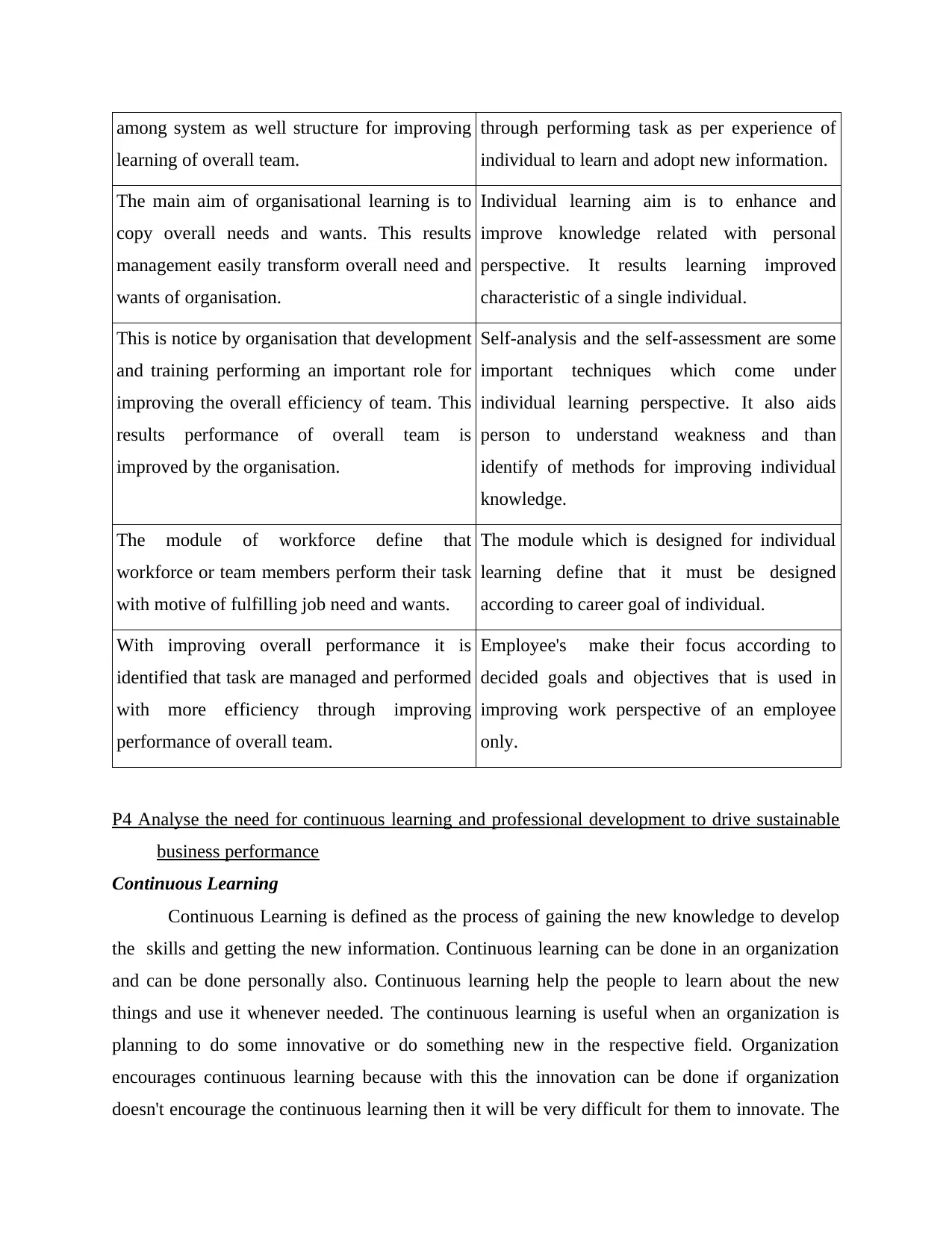
among system as well structure for improving
learning of overall team.
through performing task as per experience of
individual to learn and adopt new information.
The main aim of organisational learning is to
copy overall needs and wants. This results
management easily transform overall need and
wants of organisation.
Individual learning aim is to enhance and
improve knowledge related with personal
perspective. It results learning improved
characteristic of a single individual.
This is notice by organisation that development
and training performing an important role for
improving the overall efficiency of team. This
results performance of overall team is
improved by the organisation.
Self-analysis and the self-assessment are some
important techniques which come under
individual learning perspective. It also aids
person to understand weakness and than
identify of methods for improving individual
knowledge.
The module of workforce define that
workforce or team members perform their task
with motive of fulfilling job need and wants.
The module which is designed for individual
learning define that it must be designed
according to career goal of individual.
With improving overall performance it is
identified that task are managed and performed
with more efficiency through improving
performance of overall team.
Employee's make their focus according to
decided goals and objectives that is used in
improving work perspective of an employee
only.
P4 Analyse the need for continuous learning and professional development to drive sustainable
business performance
Continuous Learning
Continuous Learning is defined as the process of gaining the new knowledge to develop
the skills and getting the new information. Continuous learning can be done in an organization
and can be done personally also. Continuous learning help the people to learn about the new
things and use it whenever needed. The continuous learning is useful when an organization is
planning to do some innovative or do something new in the respective field. Organization
encourages continuous learning because with this the innovation can be done if organization
doesn't encourage the continuous learning then it will be very difficult for them to innovate. The
learning of overall team.
through performing task as per experience of
individual to learn and adopt new information.
The main aim of organisational learning is to
copy overall needs and wants. This results
management easily transform overall need and
wants of organisation.
Individual learning aim is to enhance and
improve knowledge related with personal
perspective. It results learning improved
characteristic of a single individual.
This is notice by organisation that development
and training performing an important role for
improving the overall efficiency of team. This
results performance of overall team is
improved by the organisation.
Self-analysis and the self-assessment are some
important techniques which come under
individual learning perspective. It also aids
person to understand weakness and than
identify of methods for improving individual
knowledge.
The module of workforce define that
workforce or team members perform their task
with motive of fulfilling job need and wants.
The module which is designed for individual
learning define that it must be designed
according to career goal of individual.
With improving overall performance it is
identified that task are managed and performed
with more efficiency through improving
performance of overall team.
Employee's make their focus according to
decided goals and objectives that is used in
improving work perspective of an employee
only.
P4 Analyse the need for continuous learning and professional development to drive sustainable
business performance
Continuous Learning
Continuous Learning is defined as the process of gaining the new knowledge to develop
the skills and getting the new information. Continuous learning can be done in an organization
and can be done personally also. Continuous learning help the people to learn about the new
things and use it whenever needed. The continuous learning is useful when an organization is
planning to do some innovative or do something new in the respective field. Organization
encourages continuous learning because with this the innovation can be done if organization
doesn't encourage the continuous learning then it will be very difficult for them to innovate. The
Paraphrase This Document
Need a fresh take? Get an instant paraphrase of this document with our AI Paraphraser
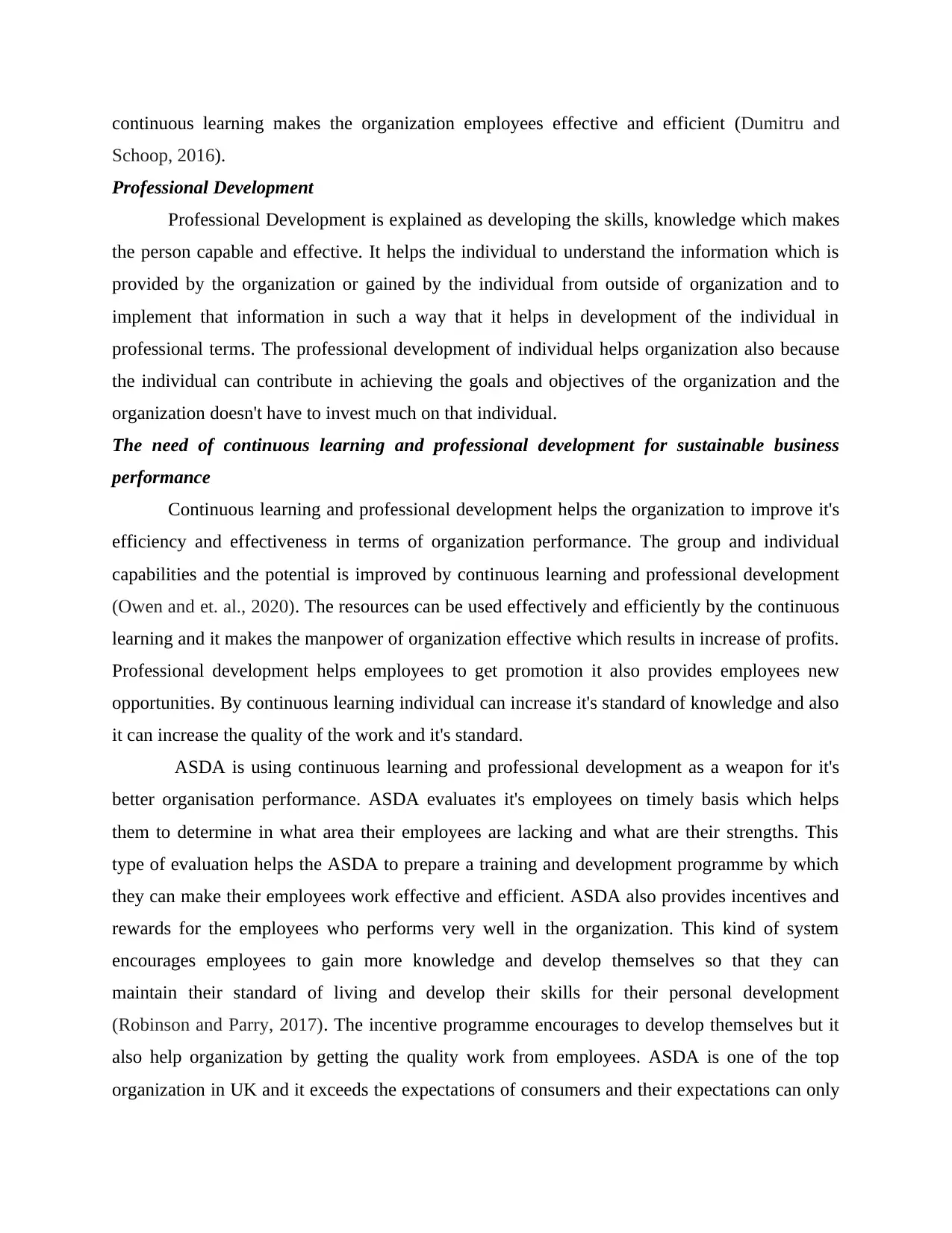
continuous learning makes the organization employees effective and efficient (Dumitru and
Schoop, 2016).
Professional Development
Professional Development is explained as developing the skills, knowledge which makes
the person capable and effective. It helps the individual to understand the information which is
provided by the organization or gained by the individual from outside of organization and to
implement that information in such a way that it helps in development of the individual in
professional terms. The professional development of individual helps organization also because
the individual can contribute in achieving the goals and objectives of the organization and the
organization doesn't have to invest much on that individual.
The need of continuous learning and professional development for sustainable business
performance
Continuous learning and professional development helps the organization to improve it's
efficiency and effectiveness in terms of organization performance. The group and individual
capabilities and the potential is improved by continuous learning and professional development
(Owen and et. al., 2020). The resources can be used effectively and efficiently by the continuous
learning and it makes the manpower of organization effective which results in increase of profits.
Professional development helps employees to get promotion it also provides employees new
opportunities. By continuous learning individual can increase it's standard of knowledge and also
it can increase the quality of the work and it's standard.
ASDA is using continuous learning and professional development as a weapon for it's
better organisation performance. ASDA evaluates it's employees on timely basis which helps
them to determine in what area their employees are lacking and what are their strengths. This
type of evaluation helps the ASDA to prepare a training and development programme by which
they can make their employees work effective and efficient. ASDA also provides incentives and
rewards for the employees who performs very well in the organization. This kind of system
encourages employees to gain more knowledge and develop themselves so that they can
maintain their standard of living and develop their skills for their personal development
(Robinson and Parry, 2017). The incentive programme encourages to develop themselves but it
also help organization by getting the quality work from employees. ASDA is one of the top
organization in UK and it exceeds the expectations of consumers and their expectations can only
Schoop, 2016).
Professional Development
Professional Development is explained as developing the skills, knowledge which makes
the person capable and effective. It helps the individual to understand the information which is
provided by the organization or gained by the individual from outside of organization and to
implement that information in such a way that it helps in development of the individual in
professional terms. The professional development of individual helps organization also because
the individual can contribute in achieving the goals and objectives of the organization and the
organization doesn't have to invest much on that individual.
The need of continuous learning and professional development for sustainable business
performance
Continuous learning and professional development helps the organization to improve it's
efficiency and effectiveness in terms of organization performance. The group and individual
capabilities and the potential is improved by continuous learning and professional development
(Owen and et. al., 2020). The resources can be used effectively and efficiently by the continuous
learning and it makes the manpower of organization effective which results in increase of profits.
Professional development helps employees to get promotion it also provides employees new
opportunities. By continuous learning individual can increase it's standard of knowledge and also
it can increase the quality of the work and it's standard.
ASDA is using continuous learning and professional development as a weapon for it's
better organisation performance. ASDA evaluates it's employees on timely basis which helps
them to determine in what area their employees are lacking and what are their strengths. This
type of evaluation helps the ASDA to prepare a training and development programme by which
they can make their employees work effective and efficient. ASDA also provides incentives and
rewards for the employees who performs very well in the organization. This kind of system
encourages employees to gain more knowledge and develop themselves so that they can
maintain their standard of living and develop their skills for their personal development
(Robinson and Parry, 2017). The incentive programme encourages to develop themselves but it
also help organization by getting the quality work from employees. ASDA is one of the top
organization in UK and it exceeds the expectations of consumers and their expectations can only
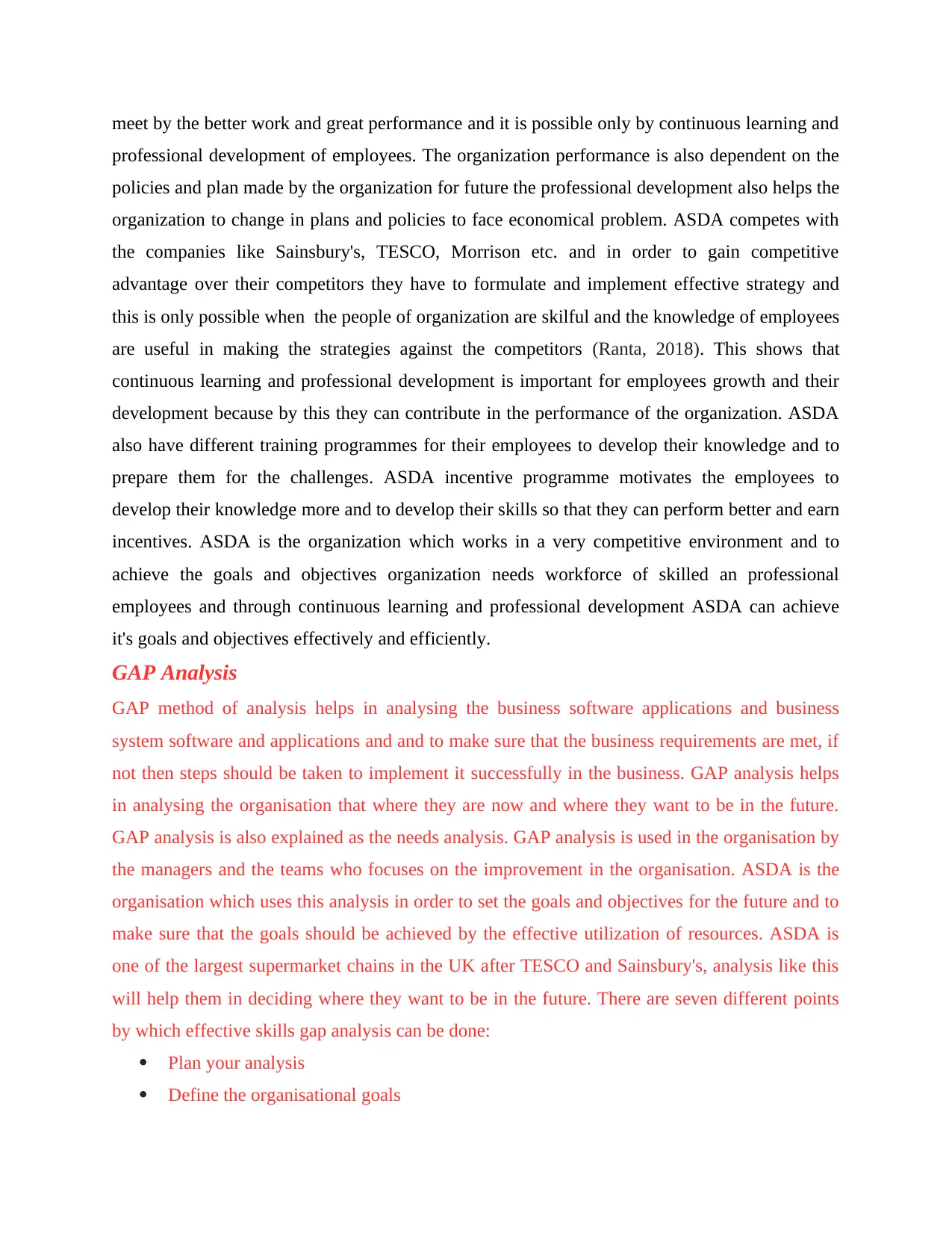
meet by the better work and great performance and it is possible only by continuous learning and
professional development of employees. The organization performance is also dependent on the
policies and plan made by the organization for future the professional development also helps the
organization to change in plans and policies to face economical problem. ASDA competes with
the companies like Sainsbury's, TESCO, Morrison etc. and in order to gain competitive
advantage over their competitors they have to formulate and implement effective strategy and
this is only possible when the people of organization are skilful and the knowledge of employees
are useful in making the strategies against the competitors (Ranta, 2018). This shows that
continuous learning and professional development is important for employees growth and their
development because by this they can contribute in the performance of the organization. ASDA
also have different training programmes for their employees to develop their knowledge and to
prepare them for the challenges. ASDA incentive programme motivates the employees to
develop their knowledge more and to develop their skills so that they can perform better and earn
incentives. ASDA is the organization which works in a very competitive environment and to
achieve the goals and objectives organization needs workforce of skilled an professional
employees and through continuous learning and professional development ASDA can achieve
it's goals and objectives effectively and efficiently.
GAP Analysis
GAP method of analysis helps in analysing the business software applications and business
system software and applications and and to make sure that the business requirements are met, if
not then steps should be taken to implement it successfully in the business. GAP analysis helps
in analysing the organisation that where they are now and where they want to be in the future.
GAP analysis is also explained as the needs analysis. GAP analysis is used in the organisation by
the managers and the teams who focuses on the improvement in the organisation. ASDA is the
organisation which uses this analysis in order to set the goals and objectives for the future and to
make sure that the goals should be achieved by the effective utilization of resources. ASDA is
one of the largest supermarket chains in the UK after TESCO and Sainsbury's, analysis like this
will help them in deciding where they want to be in the future. There are seven different points
by which effective skills gap analysis can be done:
Plan your analysis
Define the organisational goals
professional development of employees. The organization performance is also dependent on the
policies and plan made by the organization for future the professional development also helps the
organization to change in plans and policies to face economical problem. ASDA competes with
the companies like Sainsbury's, TESCO, Morrison etc. and in order to gain competitive
advantage over their competitors they have to formulate and implement effective strategy and
this is only possible when the people of organization are skilful and the knowledge of employees
are useful in making the strategies against the competitors (Ranta, 2018). This shows that
continuous learning and professional development is important for employees growth and their
development because by this they can contribute in the performance of the organization. ASDA
also have different training programmes for their employees to develop their knowledge and to
prepare them for the challenges. ASDA incentive programme motivates the employees to
develop their knowledge more and to develop their skills so that they can perform better and earn
incentives. ASDA is the organization which works in a very competitive environment and to
achieve the goals and objectives organization needs workforce of skilled an professional
employees and through continuous learning and professional development ASDA can achieve
it's goals and objectives effectively and efficiently.
GAP Analysis
GAP method of analysis helps in analysing the business software applications and business
system software and applications and and to make sure that the business requirements are met, if
not then steps should be taken to implement it successfully in the business. GAP analysis helps
in analysing the organisation that where they are now and where they want to be in the future.
GAP analysis is also explained as the needs analysis. GAP analysis is used in the organisation by
the managers and the teams who focuses on the improvement in the organisation. ASDA is the
organisation which uses this analysis in order to set the goals and objectives for the future and to
make sure that the goals should be achieved by the effective utilization of resources. ASDA is
one of the largest supermarket chains in the UK after TESCO and Sainsbury's, analysis like this
will help them in deciding where they want to be in the future. There are seven different points
by which effective skills gap analysis can be done:
Plan your analysis
Define the organisational goals
⊘ This is a preview!⊘
Do you want full access?
Subscribe today to unlock all pages.

Trusted by 1+ million students worldwide
1 out of 21
Related Documents
Your All-in-One AI-Powered Toolkit for Academic Success.
+13062052269
info@desklib.com
Available 24*7 on WhatsApp / Email
![[object Object]](/_next/static/media/star-bottom.7253800d.svg)
Unlock your academic potential
Copyright © 2020–2025 A2Z Services. All Rights Reserved. Developed and managed by ZUCOL.




